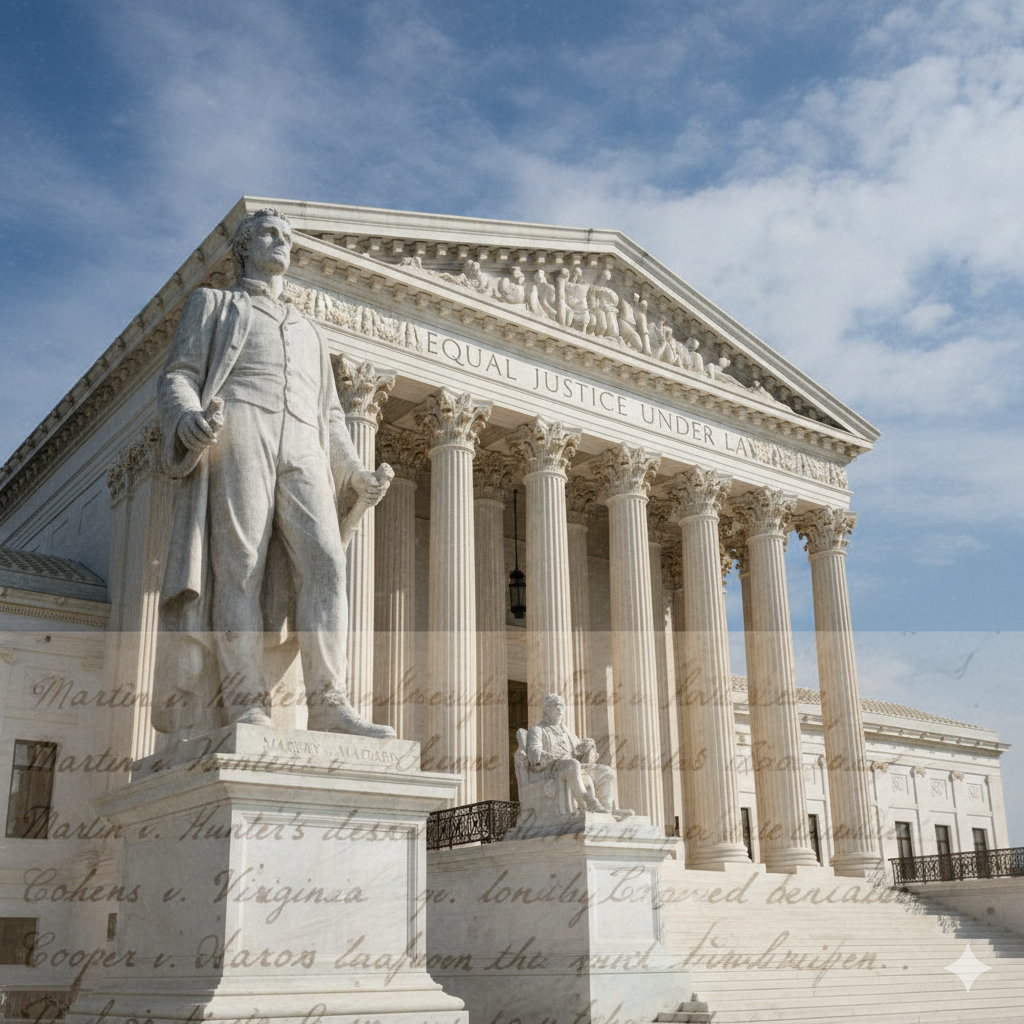The Architecture of Supremacy: Securing the Supreme Court’s Dominion Over State Sovereignty
It was the backbone of the American law that Marbury v. Madison established the judiciary’s power to review the constitutionality of federal action. This principle of horizontal review, the Court checking its co-equal branches, is rightly seen as a cornerstone of the modern-day republic. Yet, it addresses only one dimension of power. The more complex and constitutionally fraught question was the vertical one: could the federal judiciary impose its will upon the states, forcing the highest courts of sovereign entities to bend to its interpretation of the law?
The answer, which fundamentally defined the structure of American federalism and the role of the Supreme Court, was not a foregone conclusion. It was precisely constructed through a series of seminal cases that transformed the Supreme Court from a co-equal federal branch of the government into the ultimate interpreter of the Constitution.
The Crucible: Martin v. Hunter’s Lessee
The initial crucible for this contest was Martin v. Hunter’s Lessee. This issue was born out of a Virginia land dispute butquickly escalated into an issue of jurisdiction and sovereignty. The nucleus of the case was a dispute over property that was once owned by a British loyalist. Virginia’s Court of Appeals, the state’s highest court, sided with a claimant whose title derived from the state. The U.S. Supreme Court, citing the supremacy of federal treaties, reversed this decision.
In a remarkable act of judicial defiance, the Virginia court refused to obey. It issued a formal opinion declaring that as a court of a separate and distinct sovereignty, it was not subject to the appellate authority of the United States Supreme Court. The federal government and the states, it argued, were equal sovereigns within their own spheres.
This precipitated a second hearing before the Supreme Court, where Justice Joseph Story delivered one of the most consequential opinions in its history. Sidestepping direct confrontation, Justice Story constructed the intellectual architecture for federal judicial supremacy. First, he reasoned from constitutional structure: if Congress had not created lower federal courts, the Supreme Court’s appellate jurisdiction would be meaningless unless it could review state court decisions on federal questions.
Second, he invoked the necessity of impartiality, observing that the Constitution was designed to mitigate the influence of "state attachments”, state prejudices, state jealousies, and state interests.
Finally, and most crucially, he articulated the imperative of uniformity. Without a single, final interpreter of federal law, the Constitution and statutes of the United States could mean something different in every state, leading to a fractured and incoherent legal system. The union, he argued, demanded a uniform rule of law, and only the Supreme Court could provide it.
The Doctrine Fortified: Cohens v. Virginia
A few years later, Cohens v. Virginia put the theory to the test once more. Two brothers were found guilty by the state of violating Virginia law by selling lottery tickets in the District of Columbia. Virginia contended that state criminal proceedings, especially those in which a state was named as a party, were not within the Supreme Court's appellate jurisdiction. This was an effort to make a noteworthy deviation from the Martin precedent.
Writing for a unanimous Court, Chief Justice John Marshall unwaveringly reaffirmed the authority of the federal judiciary. He refuted Virginia's claim, stating that the Court's jurisdiction depended on the facts of the case rather than the parties' identities.
Furthermore, he offered a pragmatic and incisive rationale for federal oversight, noting that state judiciaries, often "dependent for office and for salary on the will of the legislature," could not be relied upon as the final guardians of federal constitutional rights.
The Principle Tested: Cooper v. Aaron
This established supremacy remained largely settled for almost a century however the ultimate test to this legal doctrine would come not in a courtroom debate, but in the crucible of the Civil Rights Movement. In Cooper v. Aaron (1958), the state of Arkansas openly defied a federal court’s desegregation order, claiming it was not bound by the Supreme Court’s interpretation of the Fourteenth Amendment in Brown v. Board of Education.
The Supreme Court’s response was a singular act of judicial solidarity and a resounding declaration of its own authority. In an opinion pointedly signed by all nine justices, the Court declared that Marbury v. Madison’s proclamation "that the federal judiciary is supreme in the exposition of the law of the Constitution" is a "permanent and indispensable feature of our constitutional system." It held that the interpretation of the Fourteenth Amendment enunciated in Brown was the supreme law of the land and was binding on every state official.
These three cases helped establish the essential pillars of the Supreme Court's authority. They clear constitutional hierarchy and also help transform the abstract promise of a "supreme Law of the Land" into reality. The ongoing dialogue and frequent discord between state and federal power continues to this day, but the fundamental principle of who possesses the final interpretive authority is a settled question, forged in these foundational legal contests.
References
Martin v. Hunter's Lessee, 14 U.S. 304 (1816).
Cohens v. Virginia, 19 U.S. 264 (1821).
Brown v. Board of Education of Topeka, 347 U.S. 483 (1954).
Cooper v. Aaron, 358 U.S. 1 (1958).
Marbury v. Madison, 5 U.S. 137 (1803).
By: Arjan Bir Sodhi
Masters in Law in Dispute Resolution, Pepperdine University
For: Lex Republica

